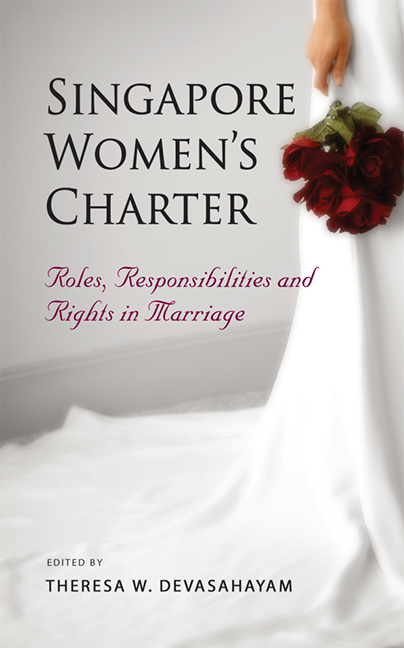Book contents
- Frontmatter
- Contents
- Contributors
- Foreword
- Keynote Address
- 1 Legal Mechanisms for Protecting Women's Rights: Examples from Southeast Asia
- 2 The Women's Charter, 1961: Where We Were Coming From and How We Got There
- 3 Significant Provisions in the Women's Charter
- 4 A Lawyer's Perspective on How Divorcees View the Women's Charter
- 5 “The Morning After”: Understanding and Exploring the Psychosocial Impact of the Women's Charter on Families Experiencing Domestic Violence
- 6 Epilogue: Some Thoughts on Protecting Women's Rights in the Family and Beyond
- Index
Keynote Address
Published online by Cambridge University Press: 21 October 2015
- Frontmatter
- Contents
- Contributors
- Foreword
- Keynote Address
- 1 Legal Mechanisms for Protecting Women's Rights: Examples from Southeast Asia
- 2 The Women's Charter, 1961: Where We Were Coming From and How We Got There
- 3 Significant Provisions in the Women's Charter
- 4 A Lawyer's Perspective on How Divorcees View the Women's Charter
- 5 “The Morning After”: Understanding and Exploring the Psychosocial Impact of the Women's Charter on Families Experiencing Domestic Violence
- 6 Epilogue: Some Thoughts on Protecting Women's Rights in the Family and Beyond
- Index
Summary
Introduction
I feel very privileged to be given this honour as I see so many distinguished people in the audience who are more qualified than me to fill this role. Nevertheless, I must confess that I readily accepted the invitation when I was asked as this sort of an opportunity seldom comes my way. Now that I am standing here, I am shamelessly going to take advantage of my position. Instead of an overview as might be expected of me, I am only going to speak on issues that I have some knowledge of and am passionate about. This means that I am going to leave the field wide open to the other speakers whom I think are really the substantive part of the forum and whom I salute as the real experts.
Enactment of the Charter — 1961
The PAP government enacted the Women's Charter as part of an election promise in 1959. At the second reading of the Women's Charter Bill in 1960, Minister K.M. Byrne revealed that the statute really proposed to regulate the formation of marriage and family life, but had been given the grandiose name of the “Women's Charter” because the bill was making a very great change in the personal lives of many women. We must remember that at that time polygamy was the order of the day and the bill was primarily aimed at legislating monogamy for all non-Muslims. The Women's Charter took effect on 15 September 1961. It ensured equal rights for married women vis-à-vis their husbands. In the early 1960s, this legislation was ahead of its time in promulgating the idea of marriage as an “equal cooperative partnership of different efforts”.
Shortcomings — The Need For A Family Charter
In 2011, the Women's Charter will see its golden anniversary, an age when some things need a makeover. At present, many people think that the Women's Charter is not an appropriate name for this legislation as it does not reflect the spirit of the legislation.
- Type
- Chapter
- Information
- Singapore Women's CharterRoles, Responsibilities and Rights in Marriage, pp. xiii - xxivPublisher: ISEAS–Yusof Ishak InstitutePrint publication year: 2011

